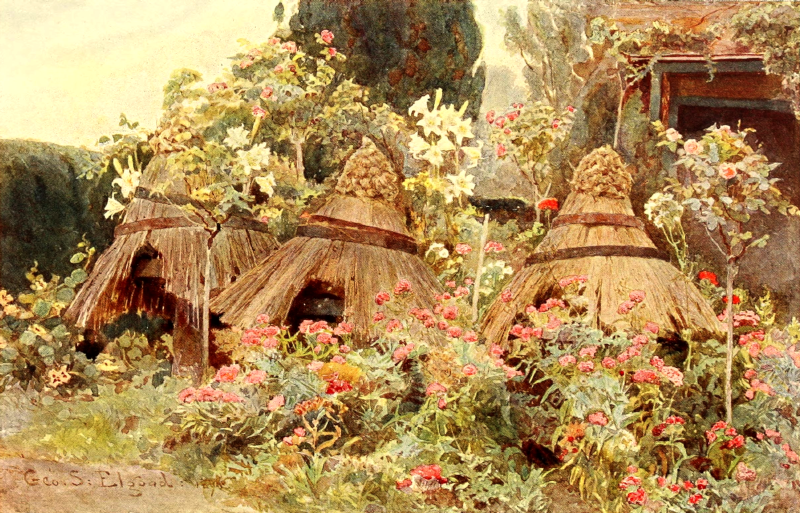LADY COVENTRY'S
NEEDLEWORK LADY COVENTRY'S NEEDLEWORK From the picture in the possession of Mrs. Appleton This is a pretty
Midland name for the good garden plant commonly called Red Valerian, or Spur
Valerian (Centranthus ruber), that groups so well in the picture with
the straw-thatched beehives. How the name originated cannot be exactly stated,
but may easily be inferred. There are several estates in the Midland Counties
belonging to the Coventry family, and, bearing in mind what we know of the home
life of our great-great-grandmothers of the late eighteenth century, it may be
assumed that some Lady Coventry of that date was specially fond of the pretty needlecraft
so widely practised among the ladies of that time. Delightful things they
are, these old needlework pictures, with a character quite different from that
of their predecessors of Jacobean times. These were much stiffer in treatment
and usually had figures; a lady and gentleman and a dog being usual subjects,
and trees looking like those out of a Noah's Ark, no doubt interpretations of
the stiffly-cut yew and box trees of the gardens of the same times. But the workers of the
flower-pictures of a hundred years later, and into the first quarter of the
nineteenth century, for the most part chose flowers alone for their subjects.
Sometimes a drawing was made, but many of them look as if they were worked
direct from the flowers. It would appear that the worker would begin in the
spring, with a Hyacinth; then would come Anemones, Tulips, Auriculas, Lilac,
Roses and Lilies; a jumble of seasons but a concord of pretty things, and all done
with a simplicity, a sweetness, a directness of intention and absence of strain
or affectation, that give them a singular charm. One such picture that I have
before me must have been begun in May, and finished, perhaps, in August and September;
for the first flower in the upper left-hand corner, where the work would
naturally begin, is a thyrse of Lilac, and the last, low down on the right, is
a Nasturtium; while the intermediate flowers, following each other in what
would be approximately their natural sequence, come in between. These are Pansy,
Rose, Sweet Pea, Love-in-a-Mist, Lily, Larkspur, Convolvulus, Carnation,
Jasmine and Passion-flower; and one Daisy-shaped flower, whose identity,
considering the numbers of possible Composites and the somewhat vague manner of
the rendering, cannot be determined, though all the other flowers are capitally
done and could not be mistaken. The disk of the
Daisy-flower is worked in a mass of those little knots that sit closely together,
the secret of whose making is known to every good needlewoman. They are a
capital direct imitation of the group of anthers in the centre of a flower. The glory of the
picture, and what was evidently the delight of the worker, is the Love-in-a-Mist,
which stands above the others in the middle top of the picture. The tender blue
of the flower, shading to white, the sharply-jagged edges of the petals, the
green upstanding forms in the centre, and, above all, the fennel-like divisions
of the involucre and the leaves, all lend themselves to satisfactory portrayal
with the needle; while the prominent position given to this charming midsummer
flower shows how the worker rejoiced in its beauty and took pleasure in
painting its form and colour in tender stitchery upon the white silken ground
of her picture. The Jasmine flowers, too, are done with evident enjoyment as
well as the neat, clear-cut leaves. The Rose is a Moss-Rose, shown in three
stages of bud and half-blown bloom, when this charming Rose is at its best; the
mossiness of the calyx being cleverly suggested by short straw-coloured
stitches that catch the light upon a ground of dull green. The working material
is floss silk, whose silvery, shining surface, dark in some lights, makes a
distinct effect of light and shade in the case of the white flowers, even
though they are worked upon a ground that is also white. Sometimes these
pictures are of a bunch of flowers without a receptacle, but often there is a
basket or vase. In this case there is a basket of very simple form, standing on
a darker table worked in the chenilles, which were also much used. They are
tiny ropes of silk velvet with an effect of rich short pile, like the old
velvets of Genoa. It is easy to see how
the Red Valerian came to be used as a model for needlework. Short stitches and
long would easily render the small divisions of the calyx and the long slender
spur and single pistil, and a quantity of this, representing the rather crowded
flower-head, would have a very good effect on a white or light ground. The plant itself is a pretty one in any garden. Botanists say that it is not indigenous, but it has taken to the country and acclimatised itself, and now behaves like a native; haunting quarries and railway cuttings in the chalk. It is a capital plant for establishing on or in walls or bold rockwork, as well as in the garden border. It is always thankful for chalk or lime in any form. |
Web and Book design,
Copyright, Kellscraft Studio
1999-2021
(Return to Web Text-ures)
